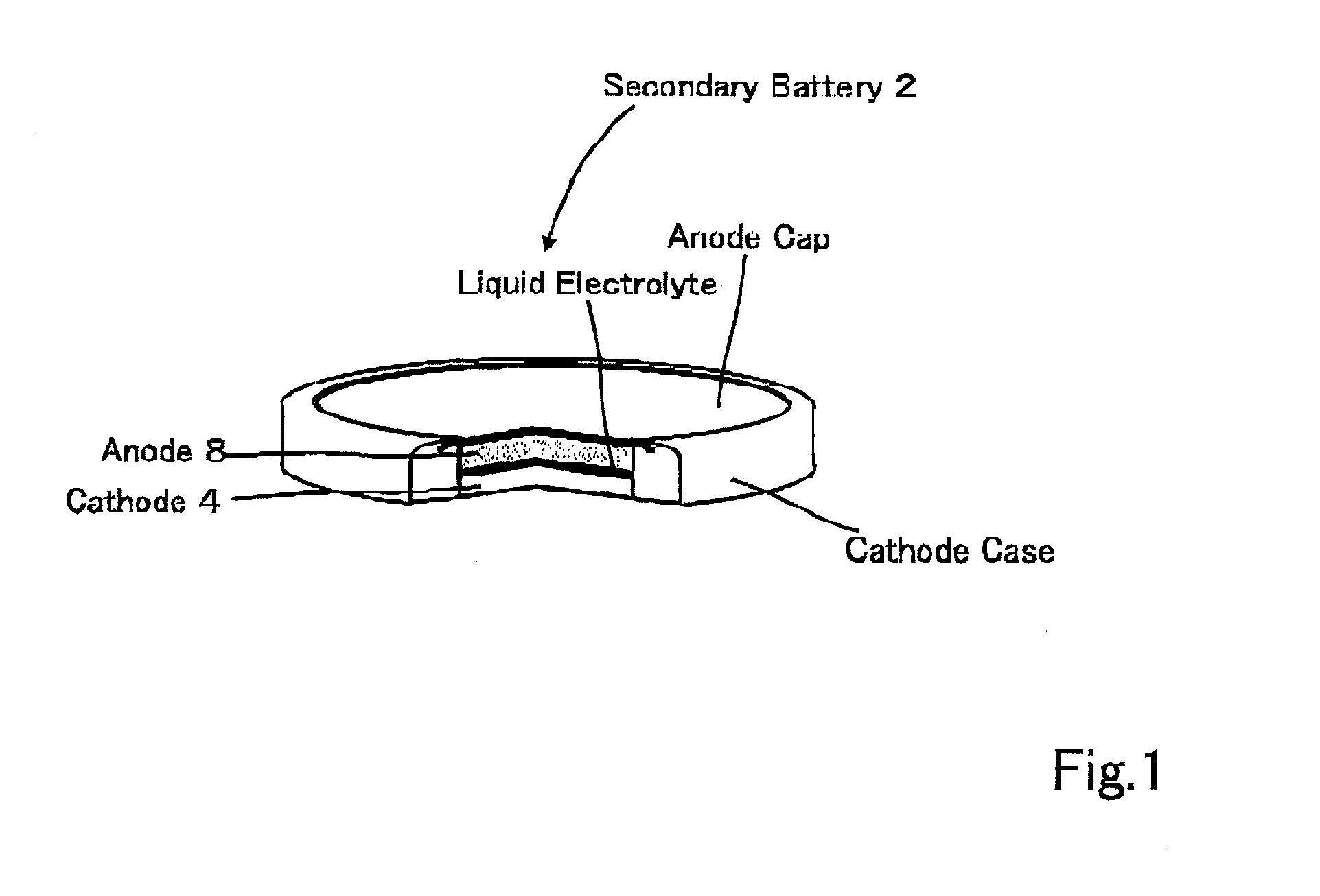Secondary battery
a secondary battery and battery technology, applied in the field of secondary batteries, can solve the problems of reducing storage characteristics, unable to consider that a proper anode material has been found, and the like, and achieve excellent storage characteristics and safety, and excellent storage characteristics
- Summary
- Abstract
- Description
- Claims
- Application Information
AI Technical Summary
Benefits of technology
Problems solved by technology
Method used
Image
Examples
example 1
[0053]Secondary batteries having various electrode configurations were produced in a present example. Table 1 shows the electrode configurations of the produced secondary batteries.
TABLE 1Type ofbatteryCathodeLiquid electrolyteAnodeBattery 1LVPLiBF4(1 mol / l) / EMIBF4LVPBattery 2NVPNaClO4(1 mol / l) / PCNVPBattery 3NVPNaBF4(0.4 mol / l) / EMIBF4nvpBattery 4LVPFLiBF4(1 mol / l) / EMIBF4LVPFLVP: Li3V2(PO4)3NVP: Na3V2(PO4)3LVPF: LiVPO4F
[0054]An electrode active material NVP (Na2V2(PO4)3), which is a NASICON structure material, was produced by baking 3NaH2PO4 and V2O3 at 900° C. in an argon atmosphere containing 5% of hydrogen for 20 hours twice. Au X ray diffraction was carried out for the produced ceramic powders, and a peak was observed according to a specific crystal structure. Moreover, another electrode active material LVP (Li3V2(PO4)3) was produced by baking 3LiH2PO4 and V2O3 at 900° C. in an argon atmosphere containing 5% of hydrogen for 20 hours twice. An X ray diffraction was carried out for...
example 2
[0059]According to a present example, charge / discharge profiles were measured respectively for the four types of coin cell type secondary batteries produced in the example 1. It should be noted that charge / discharge characteristics were measured at 25° C. fur the LVP type in a voltage range from 0 to 2.5 V at a constant current charge / discharge of 0.1 mA / cm2, and for the NVP types in a voltage range from 0 to 1.85 V at a constant current / constant voltage charge and a constant current discharge of 0.1 mA / cm2. Moreover, the charge / discharge characteristic was measured for the LVPF type in a voltage range from 0 to 2.8 V at a constant current / constant voltage charge and a constant current discharge of 0.1 mA / cm2. FIG. 2 to FIG. 5 respectively show results for the batteries 1 to 4. Moreover, FIG. 6 shows a charge / discharge cycle characteristic (25° C., 0-1.85 V, and 0.2 mA / cm2) of the battery 3 (coin cell containing NVP as the cathode active material, NaBF4 / EMIBF4 as the electrolyte, an...
PUM
| Property | Measurement | Unit |
|---|---|---|
| conductive | aaaaa | aaaaa |
| temperature | aaaaa | aaaaa |
| electric potential | aaaaa | aaaaa |
Abstract
Description
Claims
Application Information
 Login to View More
Login to View More - R&D
- Intellectual Property
- Life Sciences
- Materials
- Tech Scout
- Unparalleled Data Quality
- Higher Quality Content
- 60% Fewer Hallucinations
Browse by: Latest US Patents, China's latest patents, Technical Efficacy Thesaurus, Application Domain, Technology Topic, Popular Technical Reports.
© 2025 PatSnap. All rights reserved.Legal|Privacy policy|Modern Slavery Act Transparency Statement|Sitemap|About US| Contact US: help@patsnap.com



